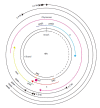Hepatitis B virus pathogenesis: Fresh insights into hepatitis B virus RNA
- PMID: 29881235
- PMCID: PMC5989240
- DOI: 10.3748/wjg.v24.i21.2261
Hepatitis B virus pathogenesis: Fresh insights into hepatitis B virus RNA
Abstract
Hepatitis B virus (HBV) is still a worldwide health concern. While divergent factors are involved in its pathogenesis, it is now clear that HBV RNAs, principally templates for viral proteins and viral DNAs, have diverse biological functions involved in HBV pathogenesis. These functions include viral replication, hepatic fibrosis and hepatocarcinogenesis. Depending on the sequence similarities, HBV RNAs may act as sponges for host miRNAs and may deregulate miRNA functions, possibly leading to pathological consequences. Some parts of the HBV RNA molecule may function as viral-derived miRNA, which regulates viral replication. HBV DNA can integrate into the host genomic DNA and produce novel viral-host fusion RNA, which may have pathological functions. To date, elimination of HBV-derived covalently closed circular DNA has not been achieved. However, RNA transcription silencing may be an alternative practical approach to treat HBV-induced pathogenesis. A full understanding of HBV RNA transcription and the biological functions of HBV RNA may open a new avenue for the development of novel HBV therapeutics.
Keywords: Genome integration; Hepatic fibrosis; Hepatitis B virus; Hepatitis B virus RNA; Hepatocellular carcinoma; MicroRNA; Smc5/6; Viral replication.
Conflict of interest statement
Conflict-of-interest statement: No potential conflicts of interest. No financial support.
Figures



References
-
- Alter HJ, Blumberg BS. Further studies on a “new” human isoprecipitin system (Australia antigen) Blood. 1966;27:297–309. - PubMed
-
- Dane DS, Cameron CH, Briggs M. Virus-like particles in serum of patients with Australia-antigen-associated hepatitis. Lancet. 1970;1:695–698. - PubMed
-
- Kim GA, Lim YS, An J, Lee D, Shim JH, Kim KM, Lee HC, Chung YH, Lee YS, Suh DJ. HBsAg seroclearance after nucleoside analogue therapy in patients with chronic hepatitis B: clinical outcomes and durability. Gut. 2014;63:1325–1332. - PubMed
-
- Gao Y, Feng J, Yang G, Zhang S, Liu Y, Bu Y, Sun M, Zhao M, Chen F, Zhang W, et al. Hepatitis B virus X protein-elevated MSL2 modulates hepatitis B virus covalently closed circular DNA by inducing degradation of APOBEC3B to enhance hepatocarcinogenesis. Hepatology. 2017;66:1413–1429. - PubMed
Publication types
MeSH terms
Substances
LinkOut - more resources
Full Text Sources
Other Literature Sources
Medical

